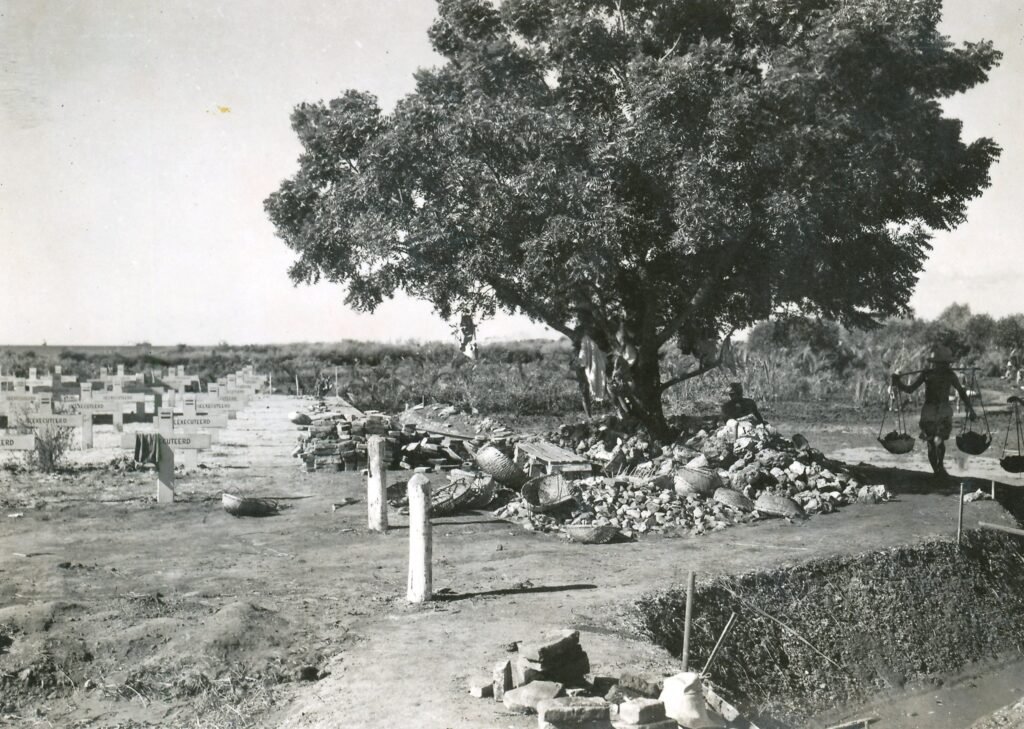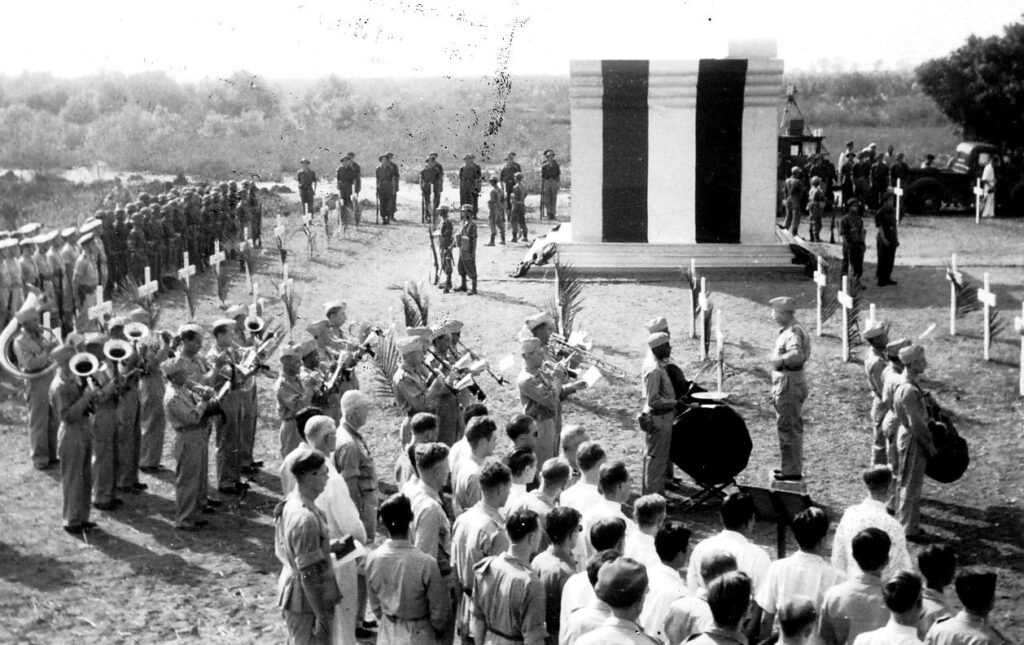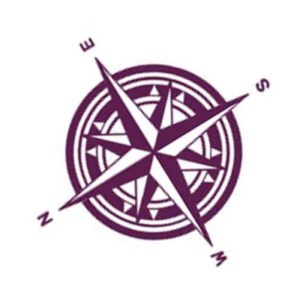Nestled along the northern coast of Jakarta, Ancol war cemetery is a place of quiet remembrance, officially inaugurated on 14 September 1946. It was the first war cemetery established by the Graves Registration Unit of the Royal Netherlands East Indies Army (KNIL). The cemetery has a unique rectangular layout, divided into two sections by a central footpath leading to a monument. Unlike the other Netherlands war cemeteries in Indonesia, Ereveld Ancol holds a particularly heavy emotional significance. This area was once used as an execution site during the war. Today, the cemetery is the final resting place for around 2,000 individuals who were executed, including Dutch and Indonesian nationals, as well as members of the Allied forces.
Video: How to get to Ereveld Ancol

Ancol war cemetery’s history is marked by its origins as a site of tragedy and loss. During the Japanese occupation, many prisoners were executed here, often under a large, old mindi tree known as the “Tree of Heaven,” or Hemelboom in Dutch. Eyewitnesses recount harrowing stories of prisoners being betrayed, abused, and left to suffer under the scorching sun before facing execution.
Ancol war cemetery is notable for its multiple graves, marked by a “verzamelbord” or mass board. These boards list the names of known victims whose remains could not be individually identified, as they were buried together after being executed. Where identities are unknown, the boards simply bear the word “geëxecuteerd” (executed) and, when possible, the location of their execution.
Over time, the cemetery became a final resting place for not only those who were executed here but also those executed elsewhere in the archipelago. Initially, the Graves Registration Unit of the Royal Netherlands East Indies Army (KNIL) developed 22 war cemeteries across Indonesia. However, in a significant consolidation effort during the 1960s, at the request of the Indonesian government, these war cemeteries were merged into the current seven war cemeteries in Java, including Ancol.
This cemetery, in particular, has seen the reburial of war victims from Bandjermasin (1961), Medan (1966), Makassar (1968) and Mandor (1968).
Ancol war cemetery stands as a powerful reminder of the harsh realities of war and the enduring impact of conflict. It is a place of reflection, where visitors can connect with the past and remember those who endured unimaginable hardship.



This monument features an angel figure, symbolizing peace and solace, with the Graves Registration Unit of the KNIL motto inscribed: “Their Spirit Has Overcome.” The monument has the inscription 1942 and 1945 on the left and right sides respectively, commemorating the victims of World War II.


Under this tree, many prisoners were executed. This tree, now immortalized in concrete, bears a plaque with Laurence Binyon’s poem “For the Fallen,” serving as a poignant reminder of the lives lost and the sacrifices made. A semicircular stone bench surrounds the tree, offering a place for meditation and reflection.


The flagpole stands as a tribute to all individuals who gave their lives during the war but are not specifically mentioned or buried within the cemetery. The inscription below the flagpole acknowledges the men and women who played vital roles in the war effort, recognising their ultimate sacrifices and ensuring their contributions are remembered and respected.


 Gate
Gate
 Information Sign
Information Sign
 Parking Area
Parking Area
 Parking Area
Parking Area
 Dike
Dike
 Pendopo, Information Centre & Guest Book
Pendopo, Information Centre & Guest Book
 Toilet
Toilet
 Flagpole
Flagpole
 Flagpole
Flagpole
 "Hemelboom" Mindi Tere
"Hemelboom" Mindi Tere
 General Monument
General Monument
 Gazebo
Gazebo
 Gazebo
Gazebo

Grave Sign Workshop
 Ereveld Ancol Manager's Office
Ereveld Ancol Manager's Office
General Visits:
Ancol war cemetery is located within the grounds of Taman Impian Ancol in North Jakarta. As such, visitors are required to purchase an entrance ticket to the Ancol recreational area in order to access the cemetery.
We understand that this may cause inconvenience, and we sincerely apologise. Please note that none of the entrance fees go to the Netherlands War Graves Foundation. The Foundation receives no portion of the proceeds and has no financial arrangement with the management of Taman Impian Ancol.
Despite this, Ancol war cemetery remains a place of quiet remembrance for those wishing to honour the memory of the war victims buried there. We welcome visitors during visiting hours and appreciate your understanding.
Individuals and small groups can explore the grounds at their own pace. Visitors are invited to take time for quiet reflection on the histories and personal stories commemorated here. The peaceful pathways and memorials offer a contemplative space for anyone wishing to pay their respects.
Group Visitation and Tours:
For those interested in a more structured visit or group tours, it’s important to note the staff’s working hours. During these times, we may be able to accommodate group visits with a guided tour led by the war cemetery manager (with prior notice and confirmed availability). These tours offer a deeper insight into the significance of the site and the stories of those commemorated here, making them ideal for educational groups, organisations, or anyone looking to understand more about this historical site.
Guided Tours with Partner Organisations:
For visitors whose schedules do not align with our working hours, or who prefer a professional guided experience, we have partnered with reputable local guides in Jakarta. Please let us know if you’re interested and we will redirect you to our partners.
If you’re interested in learning about the types of visits available at the war cemetery, please visit our Visit Us page.
Media coverage, research, flying drones, professional photography sessions and conducting events within the war cemetery requires a permit. We appreciate your understanding and cooperation in maintaining the sanctity of this solemn space.
Every day, 7:00 AM to 5:00 PM
Monday to Thursday, 7:00 AM to 2:00 PM
Friday, 7:00 AM to 11:30 AM
Saturday, 7:00 AM to 1:00 PM
Webdeveloper.id menyediakan jasa pembuatan website profesional untuk bisnis Anda yang mencakup desain modern dan kekinian. Dengan pengalaman lebih dari 1500+ project dan portofolio yang kuat, kami memastikan situs web Anda akan menonjol dan memenuhi kebutuhan bisnis Anda.